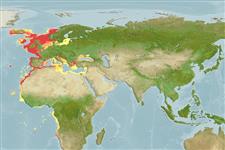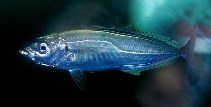Add your observation in Fish Watcher
| Native range | All suitable habitat | Point map | Year 2050 |

|
| This map was computer-generated and has not yet been reviewed. |
| Trachurus trachurus AquaMaps Data sources: GBIF OBIS |
Upload your photos and videos
Pictures | Videos | Stamps, coins, misc. | Google imageTrachurus trachurus
Picture by JJPhoto
Pictures | Videos | Stamps, coins, misc. | Google imageTrachurus trachurus
Picture by JJPhoto
Norway country information
Common names:
Hestemakrell, Taggmakrell
Occurrence: native
Salinity: marine
Abundance: | Ref:
Importance: highly commercial | Ref: FAO, 1994
Aquaculture: | Ref:
Regulations: | Ref:
Uses: no uses
Comments:
National Checklist:
Country Information: https://www.cia.gov/library/publications/resources/the-world-factbook/geos/no.html
National Fisheries Authority: http://odin.dep.no/fid/eng/
Occurrences: Occurrences Point map
Main Ref: Bauchot, M.-L., 1987
National Database:
Occurrence: native
Salinity: marine
Abundance: | Ref:
Importance: highly commercial | Ref: FAO, 1994
Aquaculture: | Ref:
Regulations: | Ref:
Uses: no uses
Comments:
National Checklist:
Country Information: https://www.cia.gov/library/publications/resources/the-world-factbook/geos/no.html
National Fisheries Authority: http://odin.dep.no/fid/eng/
Occurrences: Occurrences Point map
Main Ref: Bauchot, M.-L., 1987
National Database:
Common names from other countries
Classification / Names Nomi Comuni | Sinonimi | Catalog of Fishes(Genere, Specie) | ITIS | CoL | WoRMS | Cloffa
> Carangiformes (Jacks) > Carangidae (Jacks and pompanos) > Caranginae
Etymology: Trachurus: Greek, trachys, -eia, -ys = rough + Greek, oura = tail (Ref. 45335).
More on author: Linnaeus.
Etymology: Trachurus: Greek, trachys, -eia, -ys = rough + Greek, oura = tail (Ref. 45335).
More on author: Linnaeus.
Environment: milieu / climate zone / depth range / distribution range Ecologia
marino; oceanodromo (Ref. 51243); distribuzione batimetrica 0 - 1050 m (Ref. 54256), usually 100 - 200 m (Ref. 54256). Subtropical; 67°N - 38°S, 26°W - 42°E
Distribuzione Stati | Aree FAO | Ecosystems | Presenze | Point map | Introduzioni | Faunafri
Eastern Atlantic: from Madeira, the Straits of Gibraltar and Canary and Cape Verde Islands to South Africa; northward extending into the Mediterranean Sea and along the Atlantic coasts of Europe to Norway.
Length at first maturity / Size / Peso / Age
Maturity: Lm 22.9, range 21 - 30 cm
Max length : 70.0 cm TL maschio/sesso non determinato; (Ref. 3197); common length : 22.0 cm FL maschio/sesso non determinato; (Ref. 3397); peso massimo pubblicato: 2.0 kg (Ref. 27584)
Max length : 70.0 cm TL maschio/sesso non determinato; (Ref. 3197); common length : 22.0 cm FL maschio/sesso non determinato; (Ref. 3397); peso massimo pubblicato: 2.0 kg (Ref. 27584)
Short description Chiavi di identificazione | Morfologia | Morfometria
Spine dorsali (totale) : 9; Raggi dorsali molli (totale) : 30 - 36; Spine anali: 3; Raggi anali molli: 24 - 32. Bluish green, grey or black above, silvery white below; opercle with black spot (Ref. 3197). Lateral scales tall and keeled. Gill cover with a distinct black spot. First dorsal fin tall (Ref. 35388).
Adults form large schools in coastal areas with sandy substrate. They feed on fish, crustaceans, and cephalopods. Are batch spawners (Ref. 51846). Females lay 140,000 eggs, which hatch into 5mm long larvae (Ref. 35388). Eggs are pelagic (Ref. 4233). Utilized fresh, smoked, canned and frozen; can be fried, broiled and baked (Ref. 9988). Divided into two stocks: West stock and North Sea stock. West stock spawns in a belt from the Biscay to Ireland in early spring, migrates north and eastwards to southern Norway and northern North Sea. North Sea stock spawns in the southern North Sea in summer, migrates to central North Sea, Skagerrak and Kattegat.
Life cycle and mating behavior Maturità | Riproduzione | Deposizione | Uova | Fecundity | Larve
Main reference
Upload your references | Bibliografia | Coordinatore : Smith-Vaniz, William F. | Collaboratori
Smith-Vaniz, W.F., 1986. Carangidae. p. 815-844. In P.J.P. Whitehead, M.-L. Bauchot, J.-C. Hureau, J. Nielsen and E. Tortonese (eds.) Fishes of the north-eastern Atlantic and the Mediterranean. UNESCO, Paris. vol. 2. (Ref. 4233)
IUCN Red List Status (Ref. 130435: Version 2024-2)
Vulnerabile, vedi Lista Rossa IUCN (VU) (A2bd); Date assessed: 09 May 2013
Threat to humans
Harmless
Human uses
Pesca: elevato interesse commerciale; Pesce da pesca sportiva: si; esca: usually
FAO(pesca: production, species profile; publication : search) | FIRMS (Stock assessments) | FishSource | Sea Around Us
Informazioni ulteriori
Population dynamics
Growth parameters
Max. ages / sizes
Length-weight rel.
Length-length rel.
Length-frequencies
Mass conversion
Reclutamento
Abbondanza
Growth parameters
Max. ages / sizes
Length-weight rel.
Length-length rel.
Length-frequencies
Mass conversion
Reclutamento
Abbondanza
Life cycle
Riproduzione
Maturità
Fecundity
Deposizione
Spawning aggregations
Uova
Egg development
Larve
Dinamica popolazioni larvali
Riproduzione
Maturità
Fecundity
Deposizione
Spawning aggregations
Uova
Egg development
Larve
Dinamica popolazioni larvali
Physiology
Body composition
Nutrients
Oxygen consumption
Swimming type
Swimming speed
Visual pigments
Fish sound
Diseases & Parasites
Toxicity (LC50s)
Body composition
Nutrients
Oxygen consumption
Swimming type
Swimming speed
Visual pigments
Fish sound
Diseases & Parasites
Toxicity (LC50s)
Human related
Aquaculture systems
Profili di acquacoltura
Varietà
Ciguatera cases
Stamps, coins, misc.
Aquaculture systems
Profili di acquacoltura
Varietà
Ciguatera cases
Stamps, coins, misc.
Strumenti
Bio-Quiz | E-book | Giuda pratica | Chiavi di identificazione | Generatore frequenze di lunghezza | Strumento Parametri Biologici | Mappa dei ritrovamenti | Classification Tree
| Catch-MSY |
Special reports
Download XML
Fonti Internet
Aquatic Commons | BHL | Cloffa | BOLDSystems | Websites from users | Check FishWatcher | CISTI | Catalog of Fishes(Genere, Specie) | DiscoverLife | DORIS | ECOTOX | Faunafri | Fishtrace | GenBank(genome, nucleotide) | GloBI | GOBASE | | Google Books | Google Scholar | Google | IGFA World Record | MitoFish | Database Nazionali | Otolith Atlas of Taiwan Fishes | Acquari pubblici | PubMed | Reef Life Survey | Scirus | SeaLifeBase | Tree of Life | Wikipedia(Go, ricerca) | World Records Freshwater Fishing | Zoological Record
Estimates based on models
Preferred temperature (Ref. 115969): 10.6 - 16.6, mean 13.3 (based on 165 cells).
Phylogenetic diversity index (Ref. 82804): PD50 = 0.5001 [Uniqueness, from 0.5 = low to 2.0 = high].
Bayesian length-weight: a=0.00813 (0.00745 - 0.00887), b=2.96 (2.94 - 2.98), in cm Total Length, based on LWR estimates for this species (Ref. 93245).
Trophic level (Ref. 69278): 3.7 ±0.0 se; based on diet studies.
Resilienza (Ref. 120179): Medio, tempo minimo di raddoppiamento della popolazione 1.4 - 4.4 anni (K=0.12-0.16; tm=2-4; tmax=11; Fec=70,000).
Prior r = 0.39, 95% CL = 0.26 - 0.58, Based on 13 full stock assessments.
Fishing Vulnerability (Ref. 59153): High vulnerability (56 of 100).
Climate Vulnerability (Ref. 125649): Low vulnerability (25 of 100).




